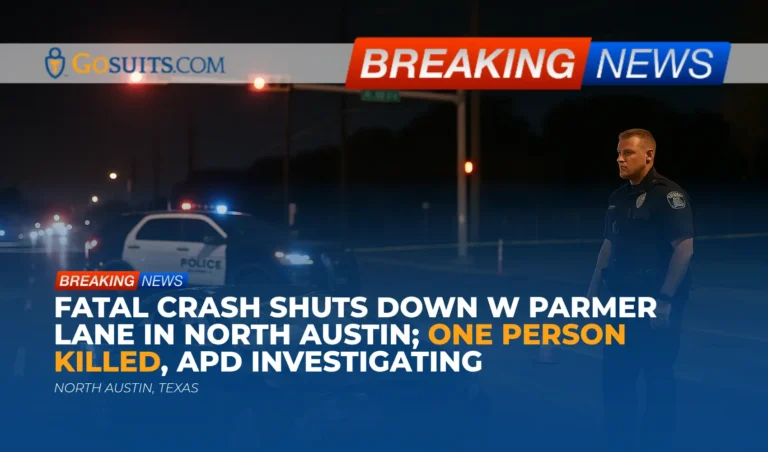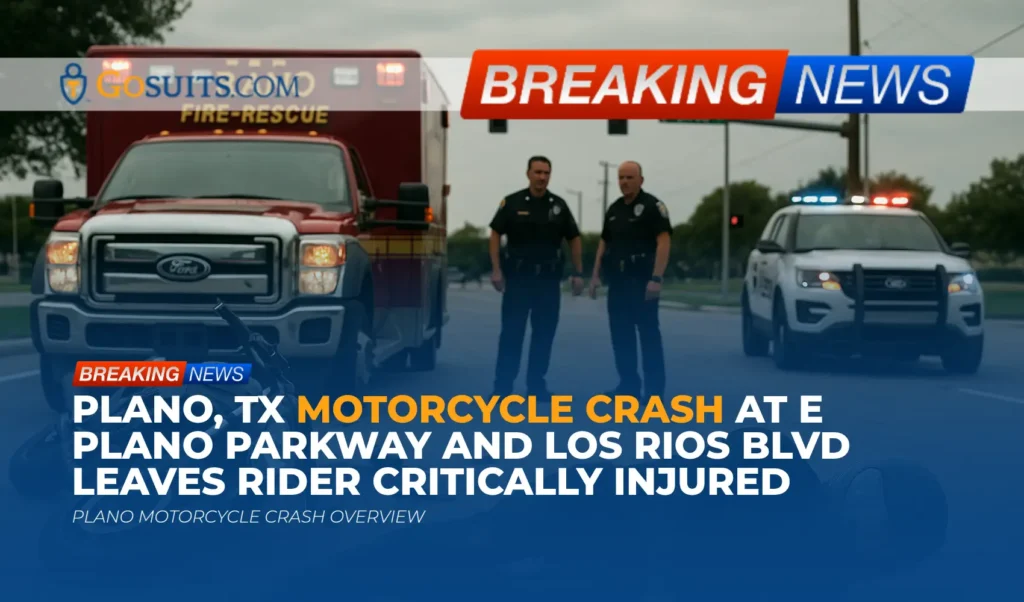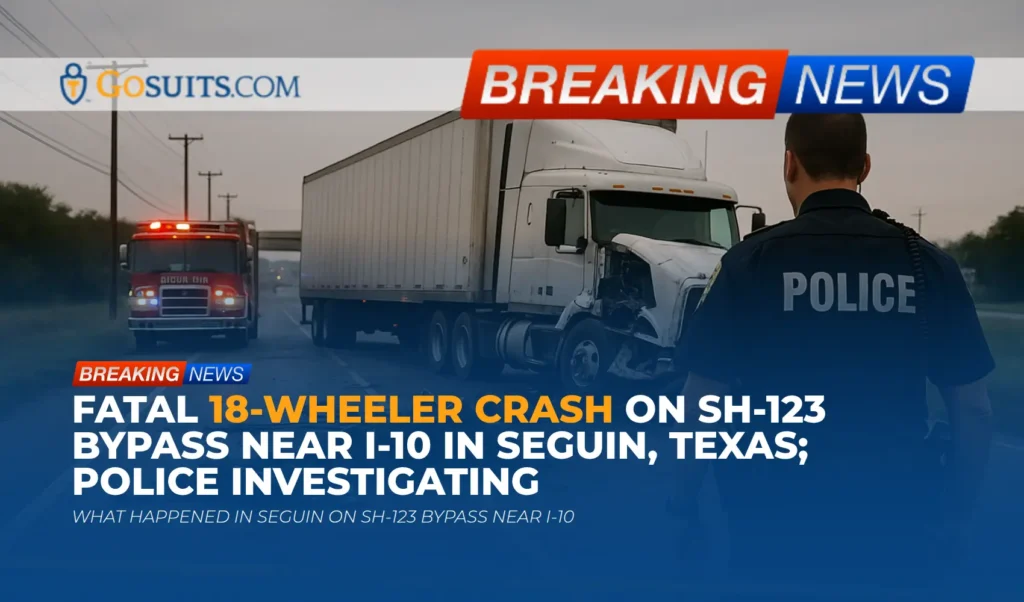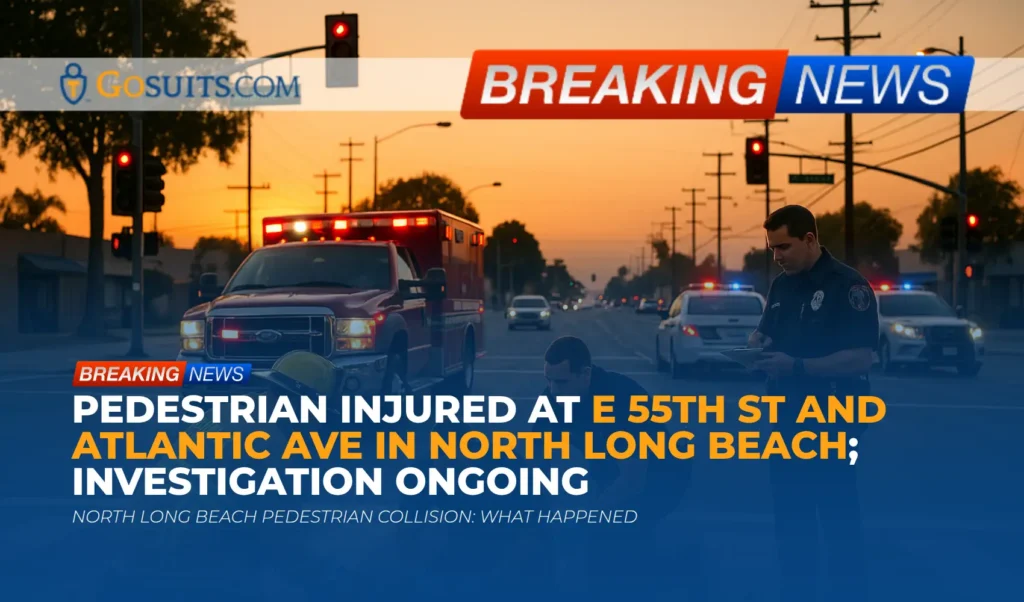- What we know about the North Austin crash on W Parmer Lane
- Which agencies are involved and what they do
- How fatal crash investigations typically proceed in Texas
- Key records families may need and how to request them
- Safety and legal considerations in serious collisions
- Insurance issues after a deadly crash in Texas
- Practical steps to preserve evidence and protect rights
- Where to find official updates
- Grief and victim support resources in Austin
- Why acting promptly matters
- Commentary from Gosuits Austin, Texas Personal Injury Attorney
- Sources
What we know about the North Austin crash on W Parmer Lane
One person died after a serious car crash in North Austin on the evening of October 21, 2025. According to Austin-Travis County EMS, first responders were dispatched at approximately 9:18 p.m. to the 500 block of W Parmer Lane. Austin Police reported that Parmer Lane was shut down in both directions between I-35 and Cedar Lake Drive while authorities worked the scene. Drivers in the area were asked to use alternate routes. Details such as the number of vehicles involved, potential causes, and the identity of the person who died had not been released at the time of the initial report. The information above comes from Austin Police Department and Austin-Travis County EMS brief public updates.
Time, place, and immediate response
The reported location is a busy corridor in North Austin near a major interstate. Emergency medical services and police responded quickly after 9 p.m., which is a higher-risk period on urban roads due to reduced visibility and often increased traffic flow returning from evening activities. In fatal crashes, EMS prioritizes life-saving measures for any survivors and secures the scene for safety, while law enforcement begins documenting evidence for a formal collision investigation.
Road closures and community impact
When a roadway is closed after a fatal collision, it allows investigators to collect measurements, photograph the scene, and, if necessary, reconstruct events to understand what happened. Although closures can cause delays and inconvenience, they are a critical part of ensuring a thorough and accurate investigation.
Which agencies are involved and what they do
Austin-Travis County EMS
Austin-Travis County EMS provides emergency medical response, on-scene triage, transport, and coordination with receiving hospitals. In fatalities, the agency also coordinates with the county medical examiner’s office and law enforcement. Patient care reports are created for individuals treated or transported, and those records are generally protected health information. Some non-medical incident data may be available through public information processes.
Austin Police Department
APD typically manages traffic control, scene security, evidence collection, witness interviews, and crash documentation. For fatal collisions, APD’s specialized investigators may be called to conduct a more detailed inquiry. Public updates are often limited at the outset to preserve the integrity of the investigation. A formal Texas crash report is filed and later made available through Texas’s statewide crash records system.
Travis County Medical Examiner
The Travis County Medical Examiner’s Office determines cause and manner of death in cases under its jurisdiction and may conduct an autopsy. The office maintains records, including autopsy reports where performed, and coordinates with next of kin for death notifications and documentation needed for funeral arrangements and vital records.
How fatal crash investigations typically proceed in Texas
While every case is unique, there are common steps investigators use to understand a deadly crash. These steps are meant to document facts rather than assign blame prematurely.
Scene documentation and evidence preservation
Investigators generally photograph the scene, measure roadway evidence such as tire marks and debris patterns, document vehicle resting positions and damage, and note lighting, weather, and roadway conditions. They may look for skid marks, yaw marks, and roadway friction characteristics that can reveal speed or maneuvering before impact. Investigators also identify and interview witnesses and canvass for nearby surveillance or dash camera footage that might show the lead-up to the collision.
Vehicle inspections and data
Modern vehicles often contain event data recorders that can capture pre-crash speed, braking, throttle position, and seat belt usage for a short interval before impact. When legally authorized, investigators may download this data to help reconstruct events. They may also examine potential mechanical issues if suggested by the evidence.
Potential contributing factors examined
Common factors assessed include driver attentiveness and distraction, impairment, speed relative to conditions, compliance with traffic signals, lane discipline, right-of-way, visibility, and the effect of roadway design or hazards. If a commercial vehicle is involved, investigators may review driver hours-of-service, maintenance logs, and company safety practices.
How and when information is released
Initial public statements often focus on safety and closures. More detailed information can take days or weeks as reports are completed. In Texas, a formal crash report is filed and becomes available via the statewide records system after processing. Medical examiner determinations can take additional time if toxicology or ancillary studies are required.
Key records families may need and how to request them
After a deadly collision, obtaining official records can help families understand what happened and handle necessary affairs. The offices and processes below are specific to Austin and Texas.
Texas crash report (from TxDOT)
Texas law enforcement submits official crash reports to the Texas Department of Transportation’s Crash Records Information System. Eligible requestors can purchase a copy online. You will generally need details like the date of crash, location, and involved names if known. Processing times vary, and reports may not be immediately available while the agency finalizes the submission. See TxDOT’s portal at TxDOT CRIS Crash Reports.

APD public information and supplemental records
Beyond the official crash report, families may request supplemental records from the City of Austin, such as call-for-service logs, Computer Aided Dispatch records, and certain reports or recordings, subject to legal restrictions. Requests are made through the City of Austin’s Public Information Request system at austintexas.gov/pir. Some materials, including portions of body-worn camera footage or witness information, may be redacted or withheld under Texas law to protect privacy or the integrity of an investigation.
EMS patient care information
If EMS treated or transported an individual, there is typically a patient care report. Access to medical records is governed by privacy laws and usually limited to the patient or legal next of kin/personal representative. For non-medical incident details, a public information request to the City of Austin can be used. Start with the City portal at austintexas.gov/pir and specify Austin-Travis County EMS records when submitting.
Autopsy report and death certificate
The Travis County Medical Examiner’s Office provides autopsy findings (when performed) and can guide next of kin on obtaining reports. Visit Travis County Medical Examiner and its Records page for instructions. Death certificates in Texas are issued through the Department of State Health Services Vital Statistics; information on ordering is at Texas DSHS Death Records.
Traffic engineering records and signal data
Sometimes, traffic signal timing plans, maintenance logs, or camera footage are relevant. In Austin, these records are held by the City’s Transportation and Public Works Department. Footage may be limited and often overwritten quickly. A targeted public information request submitted through austintexas.gov/pir that specifies the date, time window, intersection, and type of record requested improves the chance of locating responsive materials.
Safety and legal considerations in serious collisions
The law requires drivers involved in crashes to stop, render aid when feasible, and report certain crashes to authorities. In Texas, crashes involving injury or death carry specific reporting and other obligations. See the Texas Transportation Code provisions on accidents and accident reports at Transportation Code, Chapter 550.
Potential civil liability paths
In civil cases arising from fatal collisions, investigators and counsel often look at multiple potential sources of liability. Without speculating about this specific crash, these are common avenues explored in Texas wrongful death and survival claims:
- Negligent driving by an at-fault motorist such as speeding, distraction, or failure to yield.
- Employer responsibility if a driver was within the course and scope of employment, potentially invoking company insurance and policies.
- Product or mechanical issues if evidence suggests a vehicle defect contributed to the crash.
- Roadway conditions or traffic control issues where evidence supports an unusual hazard or malfunction, understanding that claims against government entities have stringent limits and notice requirements.
Texas recognizes wrongful death and survival actions by statute. Eligible family members may bring wrongful death claims, and the decedent’s estate may bring a survival action. See Civil Practice and Remedies Code, Chapter 71.
Comparative responsibility
Texas applies proportionate responsibility. If more than one party bears fault, responsibility can be allocated by percentage. A claimant typically cannot recover if found more than 50 percent responsible. See Chapter 33, Proportionate Responsibility.
Time limits and notice requirements
Texas generally sets a two-year limitations period for personal injury and wrongful death claims, measured from the date of injury or death, with some exceptions. See Section 16.003. If a governmental entity might be implicated, the Texas Tort Claims Act requires timely notice, typically within six months, and some municipalities impose shorter local deadlines. See Section 101.101. Because deadlines can be unforgiving, it is important to understand the relevant timeframes early.
Insurance issues after a deadly crash in Texas
Texas uses an at-fault system for motor vehicle collisions. The at-fault party’s liability insurance is generally responsible for covered harms up to policy limits. Depending on the circumstances, several insurance coverages may be relevant:
- Liability coverage of a negligent driver or an employer if the driver was working at the time.
- Uninsured/underinsured motorist (UM/UIM) on the decedent’s or a household member’s policy, if the at-fault party lacks adequate insurance.
- Personal Injury Protection (PIP) or Medical Payments (MedPay), if applicable on a Texas policy, can help with certain immediate expenses regardless of fault, subject to policy terms.
- Commercial motor vehicle coverage if any involved vehicle was a company or commercial vehicle, which may trigger federal and state insurance minimums and additional records such as driver qualification files and maintenance logs.
Before communicating with any insurance adjuster, it is wise to understand how statements may be used and how policy provisions interact. Insurance companies record and evaluate statements carefully; what is said early can affect the evaluation of fault and damages later. Given the complexity, contacting an attorney for a free consultation to learn about rights and options before speaking with insurers can help avoid common pitfalls.
Practical steps to preserve evidence and protect rights
There are immediate, practical actions that can help preserve information in the weeks following a serious crash. These steps are general recommendations and should be adapted to the situation.
- Collect and organize records: Keep copies of any incident numbers from APD or EMS, medical records, funeral documents, and correspondence. Note dates, times, and contact names.
- Request official reports early: Place reminders to check the TxDOT CRIS portal for the crash report’s availability and to submit public information requests through the City of Austin if needed. Provide precise time windows and locations in requests.
- Preserve vehicles and components: If a vehicle is available, avoid authorizing repairs, disposal, or salvage until counsel can evaluate whether an inspection or event data recorder download is warranted.
- Identify witnesses and video: Write down witness names, phone numbers, or vehicle descriptions. Canvass nearby businesses or residents for cameras that might have captured the roadway around 9 p.m. on October 21 near the 500 block of W Parmer Lane. Footage often overwrites quickly.
- Document the scene conditions: If safe and lawful, capture photographs of the area in similar lighting conditions to show sight lines, signage, signal visibility, and lane markings.
- Preserve cell phone and app data: If relevant, retain phone logs, location history, rideshare receipts, and navigation app routes.
- Use written communications with insurers: If any insurer contacts you, request written correspondence. Avoid recorded statements until after obtaining a free consultation to understand rights.
- Consider spoliation letters: Where appropriate, formal notices can ask companies or agencies to preserve relevant evidence like vehicle data, dash camera footage, telematics, or signal maintenance logs.
Where to find official updates
During and after a major crash investigation, official updates typically come through government channels. For this incident, the following sources are appropriate places to check for verified information:
- TxDOT crash report availability: TxDOT CRIS Crash Reports.
- City of Austin Public Information Requests for APD, EMS, and Transportation records: austintexas.gov/pir.
- Travis County Medical Examiner for autopsy report information and decedent records: traviscountytx.gov/medical-examiner.
Authorities may also release briefings or summaries through official city websites. Timing and level of detail can vary based on investigative needs.
Grief and victim support resources in Austin
Losing someone suddenly in a traffic collision is devastating. In Austin, the police department’s victim services team can help families navigate immediate practical needs, connect with counseling resources, and understand the next steps in the criminal and civil processes.
- Austin Police Department Victim Services: Information is available at austintexas.gov/department/victim-services.
- Death certificates and vital records: For closing accounts, insurance claims, and estate matters, guidance on obtaining Texas death certificates is at Texas DSHS Death Records.
These services aim to reduce confusion during a very difficult time by providing clear information and referrals.

Why acting promptly matters
There are several time-sensitive reasons to act promptly after a deadly crash, even while grieving. Acting does not mean rushing decisions; it means preserving options.
- Evidence can disappear quickly: Traffic camera footage, business surveillance video, and dash camera recordings often overwrite within days. Vehicles may be moved, repaired, or salvaged unless preservation steps are taken.
- Public records take time: Crash reports, medical examiner documents, and public information requests require processing. Starting early helps ensure important records are available when needed for estate or insurance matters.
- Insurance communications begin fast: Adjusters may contact involved families within days. Understanding one’s rights before giving recorded statements helps avoid misunderstandings that could affect fault determinations and claim evaluations.
- Legal deadlines are strict: Texas statutes set deadlines for claims and, if government entities might be implicated, special notice requirements with shorter timelines in some cases. Knowing these windows early preserves the ability to make informed choices later.
- Financial and logistical planning: Timely access to death certificates and key documents helps with funeral arrangements, benefits, and urgent financial matters.
In light of these realities, it is prudent for anyone dealing with the aftermath of a serious crash to seek a free consultation to understand rights and options before speaking with insurance companies. What is said to an insurer can be used to shape the claim later.
Commentary from Gosuits Austin, Texas Personal Injury Attorney
Our hearts are with the loved ones affected by the fatal crash reported on W Parmer Lane. Losing someone suddenly in a roadway incident leaves families with unanswered questions and many practical hurdles. This commentary is offered for educational purposes and general information based on what authorities have publicly shared so far.
From a civil injury perspective, fatal collisions require a meticulous, fact-driven inquiry. The timeline described by EMS and police suggests a standard response to a severe crash. In cases like this, a thorough reconstruction considers driver behavior, visibility, traffic controls, and vehicle dynamics, as well as whether any commercial or governmental actors might have played a role. The goal is not to speculate but to ensure that the final picture is accurate and that families can rely on verified information when making important decisions.
In our experience, insurance companies and large corporations move quickly after serious incidents. They collect statements, assess potential liability, and look for ways to limit exposure. This is not personal; it is how their systems operate. Unfortunately, people in shock or grief may not realize how a recorded statement, a casual answer about speeds or distances, or a signed medical authorization can later be used to narrow coverage, contest causation, or undervalue loss. Adjusters can be courteous and helpful while still focusing on protecting their company’s interests.
That is why early, no-cost consultations matter. A brief conversation can clarify who should be contacted, what documents should be preserved, and how to approach insurance communications without jeopardizing future options. It does not commit anyone to a path; it simply helps ensure that families have the information needed to make informed, confident choices in a difficult moment.
Sources
- Texas Department of Transportation, Crash Records Information System (CRIS) – Purchase Crash Reports
- City of Austin Public Information Request (PIR) Portal
- Travis County Medical Examiner’s Office
- Travis County Medical Examiner – Records Requests
- Texas Department of State Health Services – Death Records
- Texas Transportation Code, Chapter 550 – Accidents and Accident Reports
- Texas Civil Practice and Remedies Code, Chapter 71 – Wrongful Death; Survival
- Texas Civil Practice and Remedies Code, Section 16.003 – Two-Year Limitations
- Texas Civil Practice and Remedies Code, Chapter 33 – Proportionate Responsibility
- Texas Civil Practice and Remedies Code, Section 101.101 – Notice to Governmental Unit
- Austin Police Department – Victim Services
- Texas Department of Transportation – End the Streak






